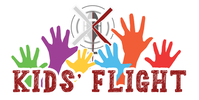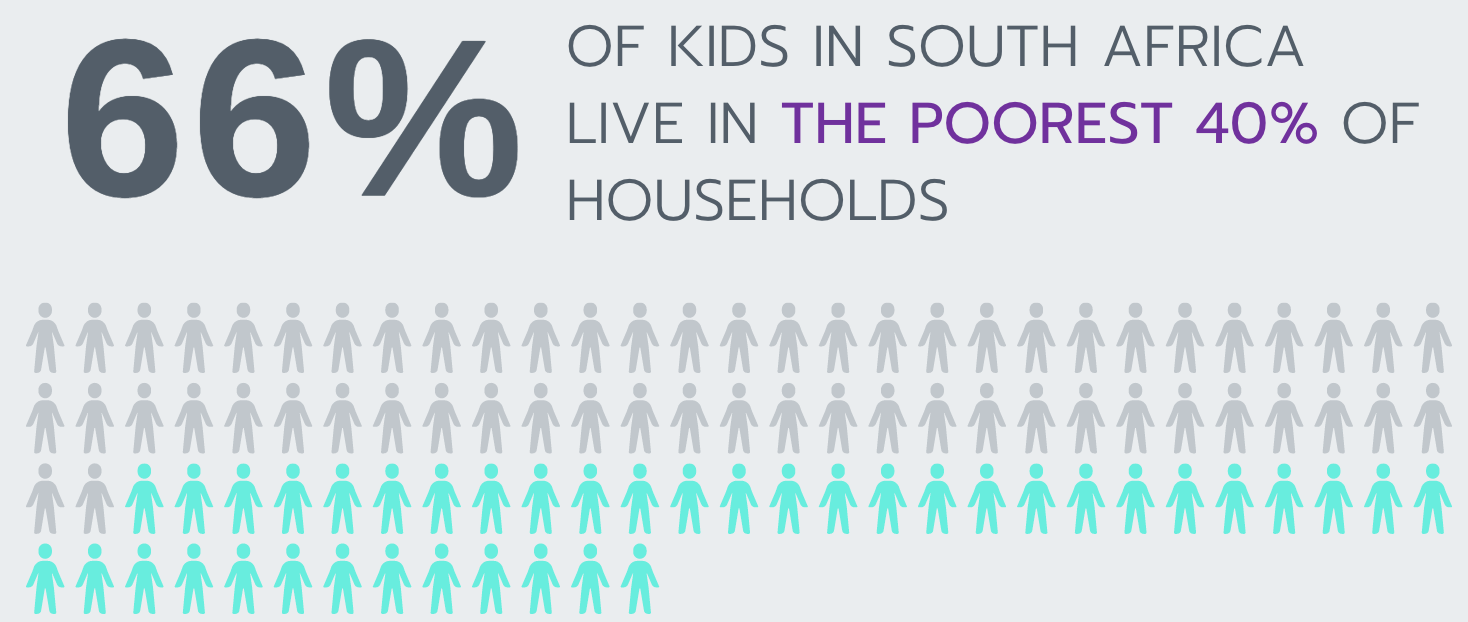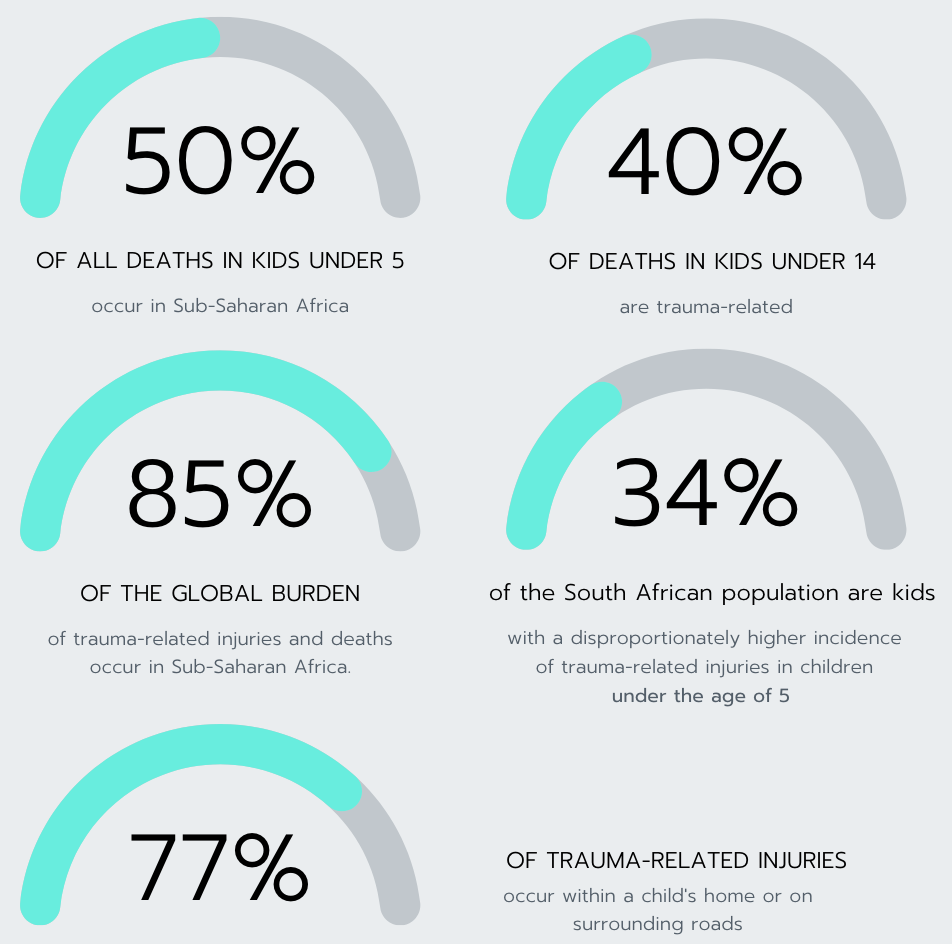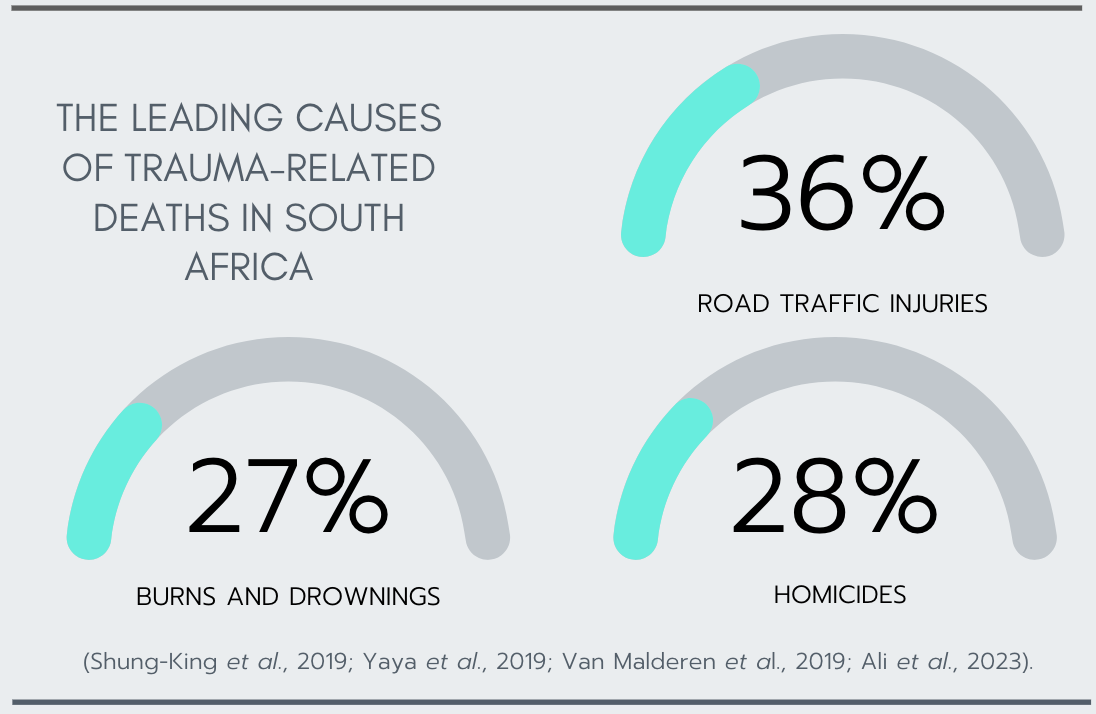Simply put, the majority of South African children live in poor households and in rural settlements. These two factors contribute to a limited access to both emergency care and ongoing specialist care, which in turn contributes to higher death rates in children.
(Shung-King et al., 2019; Van Malderen et al., 2019).
(Shung-King et al., 2019; Van Malderen et al., 2019).
Where does that leave the children?
Established trauma systems reduce death and disability rates in the injured child (Alharbi et al., 2021; Ali et al., 2023; Reynolds et al., 2017; Shung-King et al., 2019). Similarly, having dedicated paediatric emergency care networks has also reduced death and disability rates in sick children, especially under 5 years of age (Calvello et al., 2013; Damian et al., 2019; Edem et al., 2019; Shung-King et al., 2019).
What will make a difference?
The answer lies in getting the right people and resources, to the right little patient, at the right time.
When considering the population dispersion of children within rural communities in SA, their socio-economic profiles and the logistical advantages of an aeromedical service, it becomes clear how a helicopter ambulance service can make a difference by getting the right people and resources, at the right time, to the right patient.
Unfortunately current emergency services fall short of bridging the gap between where the patient is compared to where they need to be. There are niche units that provide good quality critical care retrieval services, however these units are either predominantly working in the interfaculty transfer space, or are reserved for patients who have health insurance.
This leaves the majority of South African children without any options when faced with a life-threatening emergency. 76.6% of all trauma related injuries occur either at the child’s home, or on surrounding roads (Ali et al., 2023). In South Africa 21% of all pedestrian deaths are children, with a significant proportion succumbing to injuries due to a delayed emergency services response to the scene of the accident (Alharbi et al., 2021; Shung-King et al., 2019).
Established trauma systems reduce death and disability rates in the injured child (Alharbi et al., 2021; Ali et al., 2023; Reynolds et al., 2017; Shung-King et al., 2019). Similarly, having dedicated paediatric emergency care networks has also reduced death and disability rates in sick children, especially under 5 years of age (Calvello et al., 2013; Damian et al., 2019; Edem et al., 2019; Shung-King et al., 2019).
What will make a difference?
The answer lies in getting the right people and resources, to the right little patient, at the right time.
When considering the population dispersion of children within rural communities in SA, their socio-economic profiles and the logistical advantages of an aeromedical service, it becomes clear how a helicopter ambulance service can make a difference by getting the right people and resources, at the right time, to the right patient.
Unfortunately current emergency services fall short of bridging the gap between where the patient is compared to where they need to be. There are niche units that provide good quality critical care retrieval services, however these units are either predominantly working in the interfaculty transfer space, or are reserved for patients who have health insurance.
This leaves the majority of South African children without any options when faced with a life-threatening emergency. 76.6% of all trauma related injuries occur either at the child’s home, or on surrounding roads (Ali et al., 2023). In South Africa 21% of all pedestrian deaths are children, with a significant proportion succumbing to injuries due to a delayed emergency services response to the scene of the accident (Alharbi et al., 2021; Shung-King et al., 2019).
Little Lives Matter…
Kids’ Flight is an ICU equipped helicopter air ambulance service for children; minus the health insurance constraints.
Kids’ Flight is staffed with world-class aeromedical teams, equipped and designed with child specific resources and has the real capability of getting the right people and resources, to the right little patient, at the right time.
Kids’ Flight is an ICU equipped helicopter air ambulance service for children; minus the health insurance constraints.
Kids’ Flight is staffed with world-class aeromedical teams, equipped and designed with child specific resources and has the real capability of getting the right people and resources, to the right little patient, at the right time.
References
Alharbi, R. J., Shrestha, S., Lewis, V., & Miller, C. (2021). The effectiveness of trauma care systems at different stages of development in reducing mortality: a systematic review and meta-analysis. World Journal of Emergency Surgery, 16(1), 1–12. https://doi.org/10.1186/s13017-021-00381-0
Ali, A., Ademuyiwa, A., Lakhoo, K., Kefas, J., Houmenou, E., Abdulsalam, M., Leopold, A., Bankole, R., Gbenou, S., & Covi, P. (2023). A prospective epidemiological survey of paediatric trauma in Africa: A cross-sectional study. African Journal of Paediatric Surgery, 0(0), 0. https://doi.org/10.4103/ajps.ajps_80_22
Calvello, E., Reynolds, T., Hirshon, J. M., Buckle, C., Moresky, R., O’Neill, J., & Wallis, L. A. (2013). Emergency care in sub-Saharan Africa: Results of a consensus conference. African Journal of Emergency Medicine, 3(1), 42–48. https://doi.org/10.1016/j.afjem.2013.01.001
Damian, D. J., Njau, B., Lisasi, E., Msuya, S. E., & Boulle, A. (2019). Trends in maternal and neonatal mortality in South Africa: A systematic review. Systematic Reviews, 8(1), 1–13. https://doi.org/10.1186/s13643-019-0991-y
Edem, I. J., Dare, A. J., Byass, P., D’Ambruoso, L., Kahn, K., Leather, A. J. M., Tollman, S., Whitaker, J., & Davies, J. (2019). External injuries, trauma and avoidable deaths in Agincourt, South Africa: A retrospective observational and qualitative study. BMJ Open, 9(6), 1–11. https://doi.org/10.1136/bmjopen-2018-027576
Mosca, C. G., Stein, C., & Lawrence, H. (2021). South African pre-hospital emergency care personnel’s lived experiences of managing paediatric emergencies: A qualitative research design utilising one-on-one interviews. Health SA Gesondheid, 26, 1–11. https://doi.org/10.4102/hsag.v26i0.1558
Reynolds, T. A., Stewart, B., Drewett, I., Salerno, S., Sawe, H. R., Toroyan, T., & Mock, C. (2017). The Impact of Trauma Care Systems in Low- and Middle-Income Countries. Annual Review of Public Health, 38, 507–532. https://doi.org/10.1146/annurev-publhealth-032315-021412
Shung-King, M., Lake, L., Sanders, D., & Hendricks, M. (2019). South Arican Child Gauge 2019: Child and adolescent health; Leave no one behind. In M. Shung-King, L. Lake, D. Sanders, & M. Hendricks (Eds.), South African Child Gauge 2019 (1st ed., Issue December). Cape Town: Children’s Institute, University of Cape Town.
Van Malderen, C., Amouzou, A., Barros, A. J. D., Masquelier, B., Van Oyen, H., & Speybroeck, N. (2019). Socioeconomic factors contributing to under-five mortality in sub-Saharan Africa: A decomposition analysis. BMC Public Health, 19(1), 1–19. https://doi.org/10.1186/s12889-019-7111-8
Yaya, S., Uthman, O. A., Okonofua, F., & Bishwajit, G. (2019). Decomposing the rural-urban gap in the factors of under-five mortality in sub-Saharan Africa? Evidence from 35 countries. BMC Public Health, 19(1), 1–10. https://doi.org/10.1186/s12889-019-6940-9
Alharbi, R. J., Shrestha, S., Lewis, V., & Miller, C. (2021). The effectiveness of trauma care systems at different stages of development in reducing mortality: a systematic review and meta-analysis. World Journal of Emergency Surgery, 16(1), 1–12. https://doi.org/10.1186/s13017-021-00381-0
Ali, A., Ademuyiwa, A., Lakhoo, K., Kefas, J., Houmenou, E., Abdulsalam, M., Leopold, A., Bankole, R., Gbenou, S., & Covi, P. (2023). A prospective epidemiological survey of paediatric trauma in Africa: A cross-sectional study. African Journal of Paediatric Surgery, 0(0), 0. https://doi.org/10.4103/ajps.ajps_80_22
Calvello, E., Reynolds, T., Hirshon, J. M., Buckle, C., Moresky, R., O’Neill, J., & Wallis, L. A. (2013). Emergency care in sub-Saharan Africa: Results of a consensus conference. African Journal of Emergency Medicine, 3(1), 42–48. https://doi.org/10.1016/j.afjem.2013.01.001
Damian, D. J., Njau, B., Lisasi, E., Msuya, S. E., & Boulle, A. (2019). Trends in maternal and neonatal mortality in South Africa: A systematic review. Systematic Reviews, 8(1), 1–13. https://doi.org/10.1186/s13643-019-0991-y
Edem, I. J., Dare, A. J., Byass, P., D’Ambruoso, L., Kahn, K., Leather, A. J. M., Tollman, S., Whitaker, J., & Davies, J. (2019). External injuries, trauma and avoidable deaths in Agincourt, South Africa: A retrospective observational and qualitative study. BMJ Open, 9(6), 1–11. https://doi.org/10.1136/bmjopen-2018-027576
Mosca, C. G., Stein, C., & Lawrence, H. (2021). South African pre-hospital emergency care personnel’s lived experiences of managing paediatric emergencies: A qualitative research design utilising one-on-one interviews. Health SA Gesondheid, 26, 1–11. https://doi.org/10.4102/hsag.v26i0.1558
Reynolds, T. A., Stewart, B., Drewett, I., Salerno, S., Sawe, H. R., Toroyan, T., & Mock, C. (2017). The Impact of Trauma Care Systems in Low- and Middle-Income Countries. Annual Review of Public Health, 38, 507–532. https://doi.org/10.1146/annurev-publhealth-032315-021412
Shung-King, M., Lake, L., Sanders, D., & Hendricks, M. (2019). South Arican Child Gauge 2019: Child and adolescent health; Leave no one behind. In M. Shung-King, L. Lake, D. Sanders, & M. Hendricks (Eds.), South African Child Gauge 2019 (1st ed., Issue December). Cape Town: Children’s Institute, University of Cape Town.
Van Malderen, C., Amouzou, A., Barros, A. J. D., Masquelier, B., Van Oyen, H., & Speybroeck, N. (2019). Socioeconomic factors contributing to under-five mortality in sub-Saharan Africa: A decomposition analysis. BMC Public Health, 19(1), 1–19. https://doi.org/10.1186/s12889-019-7111-8
Yaya, S., Uthman, O. A., Okonofua, F., & Bishwajit, G. (2019). Decomposing the rural-urban gap in the factors of under-five mortality in sub-Saharan Africa? Evidence from 35 countries. BMC Public Health, 19(1), 1–10. https://doi.org/10.1186/s12889-019-6940-9




